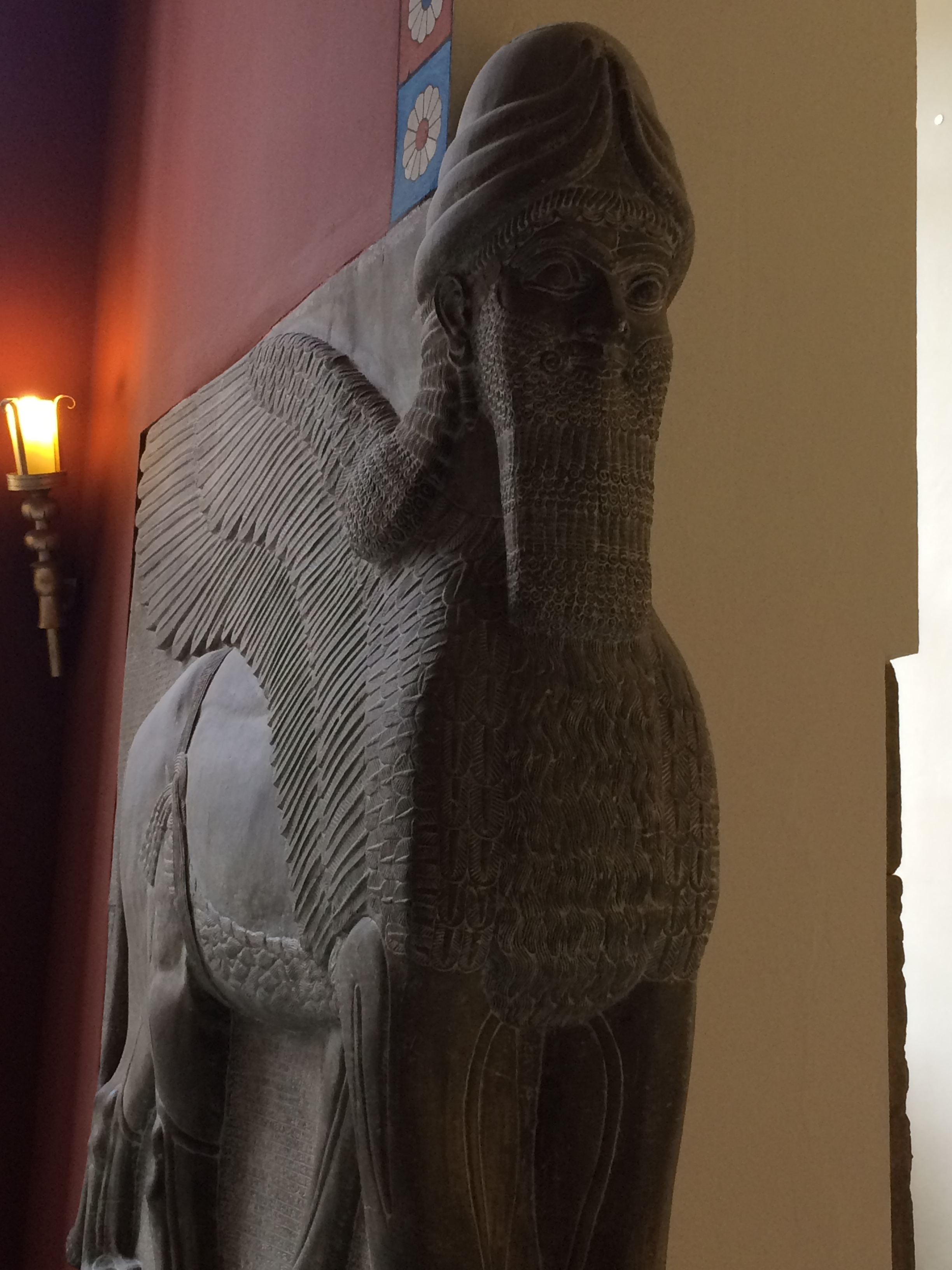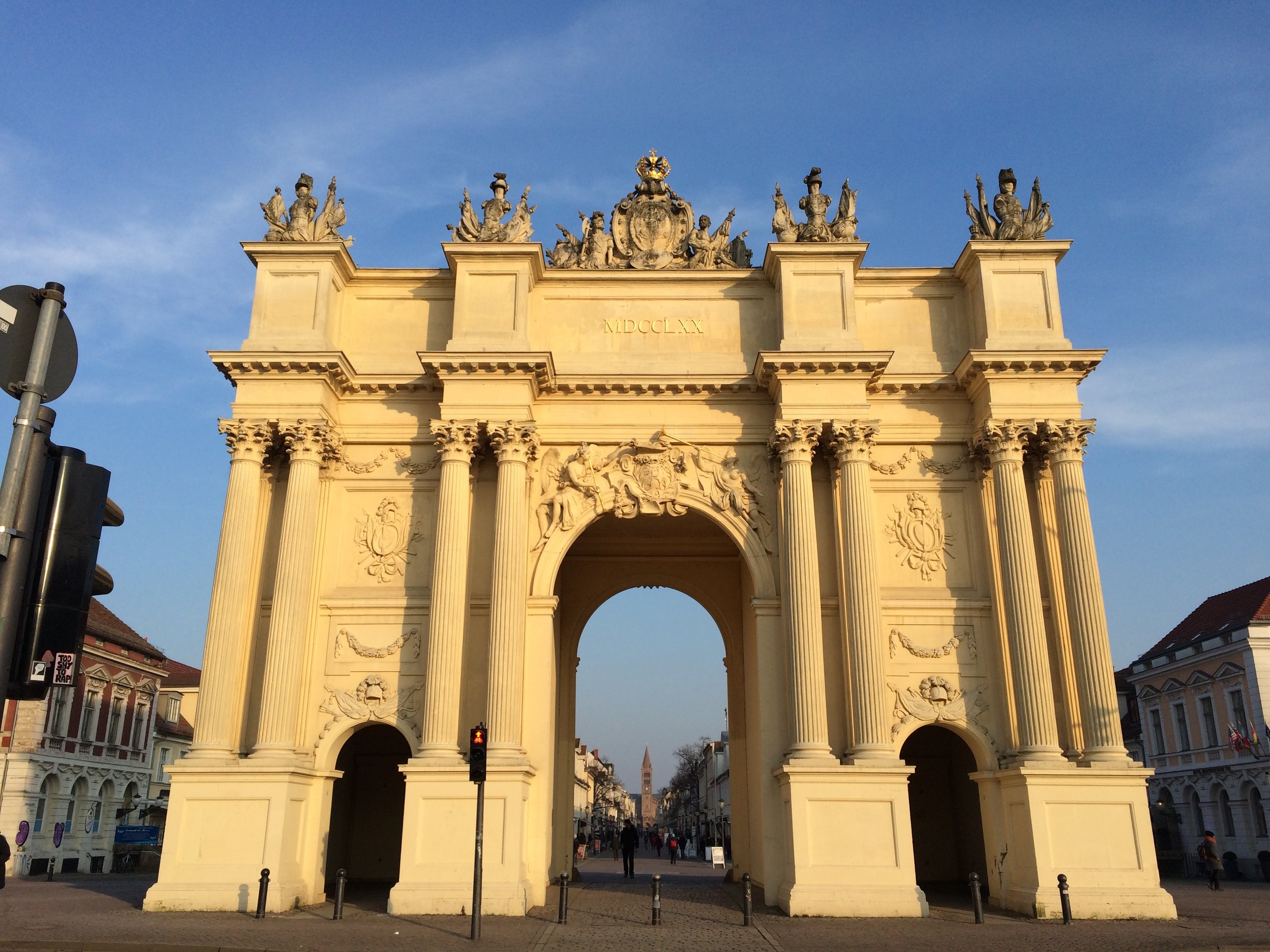Frank's first German beer
We landed in Berlin. It is very cold. We immediately navigated the metro system and got to the apartment for $5.60, rather than a $60.00 taxi ride. We have a great Airbnb located near a main road that ends at the Brandenburg Gates in the Charlottenberg district. The area has small restaurants on the corners and after the plane flight we had our first meal at the local pub. We liked the overture of a celebratory small glass of beer that was offered for free and set in front or us as a sign of welcome as soon as we sat down. We walked the neighborhood and shopped at the local grocery in order to make our own meals.
Brandenburg Gates
We signed up for our customary walking tour that started at the Gates. These have magnificent columns which you must pass through on foot. It was so cold that we all had to stop for several warm up breaks. We did get a energetic tour guide from England who lived in Berlin and had obtained her Masters degree in German history. She was a pistol. The tour was made very interesting by her knowledge and insightful comments. She talked about Berlin’s prior history and then about the rise of the Nazi party. Of note for WWII buffs were several items:
- The Holocaust Plaza designed by an American artist was powerful and controversial; it looked like a grave yard with blocks of granite of various sizes situated in walkways of different depths; so you can envision a vast grave yard yet also stand by a single tombstone and reflect upon the tragedy.
- All the Nazi buildings were destroyed in the war and thereafter, except for the Air Force building. This large office building was too functional so even the Russians used it. Some say there was a gentlemen’s agreement between the Germans and Brits not to bomb each other's headquarters, but that is hard to prove.
See the pics below, so sorry on the quality, it was so cold on our tour that our camera lens kept fogging up.
The pathway marking where the wall was throughout the city
As you know the Berlin Wall split the city. We saw parts of the actual wall and also a pathway of bricks that run through the streets to mark the path of the wall and the accompanying “dead zone”; people shot on sight in the area. There were a series of crossing checkpoints between Russians and the French, English, and American controlled sectors of Berlin. Check point C, or “Charlie”, the crossover between the Russian sector and US sector is still dramatized with bunker in the street and pseudo soldiers.
Check point Charlie
Hitler's "bunker" parking lot
The parking lot
In a nondescript, dirt parking lot maybe 4 lanes wide is the site of “Hitler’s suicide”. Under our feet on the muddy surface was the location of the bunker where Adolph Hitler and Eva Braun, his long time girlfriend and one month wife, killed themselves with poison capsules and for Hitler, a shot to the head. The Russians destroyed the large Nazi office building that covered the site after uncovering the bunker and flood the area. Hitler’s body was cremated and the ashes thrown into the Rhine river. The plan, then and now, was to disallow Hitler a burial place to martyr. The German government concurs.
Charlottenberg
Our second day was very cold again so we opted for a short 10 minute walk to the magnificent palace of Schloss Charlottenberg, the summer home of many Kaisers. There are so many King Wilhelms and King Frederichs in the German hierarchy that we can't keep them straight. This palace was used by Frederich I , the “Soldier King”, and his wife Sophie Charlotte, and the disappointing non-soldier son, Frederich II, and follows the baroque style of Germany. Each room is themed and connected to the next room by door, not hallways. The place is stunning. For example, the grand ballroom is ornately decorated in green with gold sculptures in the shape of floral trestles attached to the walls. The idea was for guests to feel like they were dancing in the gardens. The furniture that has survived are pieces of art.
Market Gate of Miletus
Museum Island
On the third day we went to the well known “museum island” located in the middle of Berlin surrounded by the river of Spree. Berlin has about 50 museums, but on this day we chose to visit 3 museums of different types that were situated next door to each other. The first was the Pergamon Museum, which has antiquities from the Assyrian area of the Middle East, now Syria and Iraq. The structures and artifacts on display are similar to Egypt, but the kings and gods are different. The most amazing presentation are the “Ishtar Gate of Babylon” and the “Market Gate of Miletus”. The Germans have erected structures that display these gates as in ancient times. Unfortunately the Pergamon Alter, pride of the museum and namesake, was not available as it is under renovation. FYI, there is a lot of construction and restoration in Berlin, including a brand new science museum that may be done in 2018.
The second was the Neues Museum, which displays artifacts from ancient Egypt and its Nubian culture. Since we had already been in Egypt, we were most interested in seeing the bust of Egyptian Queen Nerfertiti, 1340 BC., and the Golden Hat, 1000 BC., a predictor of solar movement. We had a nice lunch and dessert here and also chatted with a friendly Munich resident who told us about the things we should see there.
The third was the Alte National Gallery. The building is spectacular, inside and out. The wide central staircase allows you to climb 3 floors displaying the beautiful works of well known German and European painters and sculptures. This exhibit was really a treat, especially the sculptures. We especially enjoyed Manet's "In the Conservatory and Sculptor Johann Schadow's "Double Statue of the Princesses". We purchased a 3 day museum pass and cannot wait to pick up the other museums.
Potsdam travels
We took another walking tour to the former East Germany town of Potsdam, which started with a bus ride then on a train ride. Potsdam was destroyed significantly by Allied bombing in the war. It has been rebuilt extensively. Potsdam has the famous "Bridge of Spies" also from the Tom Hanks movie last year. It is also the site of the “Potsdam Accord” where Truman, Churchill and Stalin met to decide how to divide post war Germany. We saw the historic photo site of the 3 sitting together. This city was also the summer home and getaway of Kaiser Frederich II, who built the “Sans Souci” palace and estate. It has fantastic gardens adorned with sculptures and ornate frivolities decorating the walls and roofline. The interior, at this time, was not as opulent as his other palace in our neighborhood. He did no government work there, but did entertain the artists, musicians, and philosophers of the day, while his wife had been allowed her own dwelling elsewhere. Fred II never had kids. FYI, Fred II, though more a philosopher than a soldier actually expanded the Prussian territorial empire and saved Germany from famine with the introduction of potato crops, among other attributes. He is know as Frederich the Great, surpassing his father’s achievements.
Salad Bavarian style for dinner
We met some American expats on this tour and hit it off. After the tour we all went to a nice Bavarian restaurant with authentic German cuisine. We really like Schnitzel and veal. Best wishes to Steve and Gloria as they wind down the overseas assignment. Their grandchild was due to be born any minute.
Back to Museum Island
The next day we took the subway to our destination; to revisit Museum Island. We first visited the Alte Museum of Greek and Roman history with its ancient artifacts and sculptures gods that we could compare with our views of Egyptian antiquities. We did not overdo it, but selected the major pieces to contrast. Then we visited the Bode Museum with its Sculpture collection. More sculpture, wow! The building was gorgeous with two domes and circular staircases within a classical triangular building. But the sculptures were from renaissance artists and just inspiring.
We also visiting the German National Cathedral. It has been renovated and is magnificent on the inside with painted dome, sculptures of Calvin and Luther the originators of their faith, and beautiful religious paintings. The exterior is also impressive, but has some where and tear from the war and could use a good scrub. We walked up the winding staircase to the dome walkway that allowed us a stellar view of the city.
Alternative Berlin
Today is our last day in Berlin. We have planned our route, laundered and packed. We went on an “alternative Berlin”walking tour where we experienced the wacky stuff of this vibrant city.
The Berlin Wall with Street Art
We purchased another AB transport pass that allowed us to jump on and off metro trains until 3:00 AM. We traveled to the former East Berlin. The Friedrichshain side of the Wall where we landed is still erect and has 1/4 mile stretch of street art that was authorized and is of high quality, even if not as political as other areas. Hackescher Market has an alley by Café Cinema where there are some crazy, radical art forms and statements, and not far away is YAAM, an African youth enclave on the river Spree that has joined others in fighting rampant renovation of the waterfront. We walked through other neighborhoods that had turned former abandoned buildings into squatter cooperatives. Talk about alternative living. But it is the oddity and hipness of Berlin, especially the eastern side that draws people here. We are told Berlin’s mayor has said: “we are poor, but sexy”.
See the pics below of this area
We are off to Dresden!





























